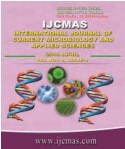


 National Academy of Agricultural Sciences (NAAS)
National Academy of Agricultural Sciences (NAAS)

|
PRINT ISSN : 2319-7692
Online ISSN : 2319-7706 Issues : 12 per year Publisher : Excellent Publishers Email : editorijcmas@gmail.com / submit@ijcmas.com Editor-in-chief: Dr.M.Prakash Index Copernicus ICV 2018: 95.39 NAAS RATING 2020: 5.38 |
Phosphorus and zinc are two essential nutrients which are required for normal plant growth. These nutrients are mutually antagonistic in certain circumstances which can cause yield reductions in many crops due to either P or Zn deficiencies. Deficiencies typically happen when a nutrient is available in small amounts. In this phenomenon, the nutrient is present in marginal to normal levels but the antagonizing nutrient is available in such a large amount that it induces the deficiency of the other. The Zn induced P deficiency is a very rare phenomenon because growers commonly apply large amounts of P fertilizer as compared to Zn fertilizer. The P induced Zn deficiency is related to the application of phosphatic fertilizers at high dose to the soils that are low or marginal in available Zn. Vesicular arbuscular mycorrhizal fungi (VAM) when applied to soils can result in marked increases in plant growth and P uptake. AM fungi benefit plant’s well establishment by enhancing plant nutrient acquisition, improving soil quality and increasing resistance to environmental stress. They also help to improve the absorption of several plant nutrients like N, P, K, Mg, Cu, Ca and Fe by the roots of plants.
 |
 |
 |
 |
 |